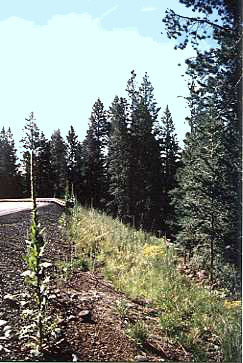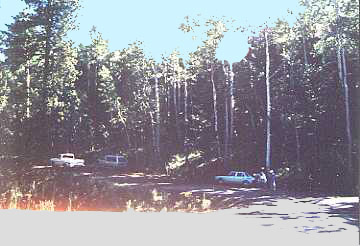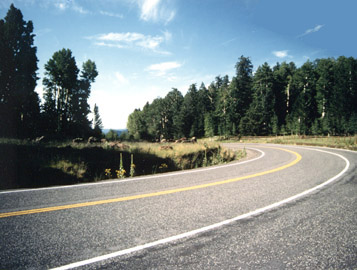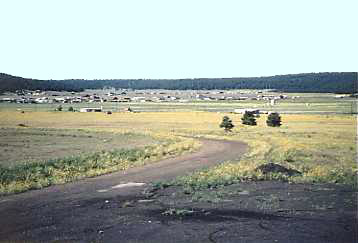 Another Stereotype of the Month entry:
Another Stereotype of the Month entry:
 Another Stereotype of the Month entry:
Another Stereotype of the Month entry:
This recently appeared in the local newspaper in Flagstaff, Ariz., a bordertown of the Navajo Reservation. If you go to the link at the bottom of the article, you will see some responses to the article and even more racist remarks are made.
Arizona Daily Sun
Editorial: Tribal sovereignty over Peaks a stretch
02/22/2002
When it comes to the making of artificial snow at the Arizona Snowbowl with reclaimed wastewater, it's time that tribal activists confront some inconvenient truths.
The first is that the San Francisco Peaks, although regarded by some Native Americans as sacred, are managed largely by the U.S. Forest Service. As such, they are "off the reservation," just as is the Moon, which Navajos also hold sacred (they oppose, among other things, landings and the spreading of Gene Shoemaker's ashes there). Neither the Peaks nor the Moon is likely to be handed over to Native American control anytime soon.
Yet Navajos and other tribes continue to make claims on the Peaks that no other ethnic or religious group would get away with. There are no burial sites or settlement ruins on the Peaks. The Peaks are simply part of a natural landscape that native peoples have elevated to unnatural stature and to which they have attempted to extend a religious sovereignty. It's one thing to worship a landscape feature from a distance. It's another to demand that the feature — whether the Moon or the Peaks — be kept in a pristine state.
Right now, the Peaks are hardly pristine. On an average summer weekend, hundreds of hikers tromp up the Humphreys Trail to the 12,633-foot-high peak. At the Snowbowl, hundreds ride the chairlift nearly to the top of Mount Agassiz. In the Inner Basin, giant pumps tap pools of snowmelt, sending the water by pipeline down to Flagstaff. Campers frolic in Lockett Meadow.
In the winter, activity on the Peaks actually slows down. When there is snow, skiing at the Snowbowl attracts several thousand people on a busy weekend day. If artificial snow is made, that level would remain constant throughout the four- or five-month season.
Yet tribal activists contend that snowmaking, especially with reclaimed wastewater, is a "desecration." That's a strong word for a process that produces water with a purity similar to drinking water. In fact, it's likely that not too many years from now, we'll be relying for drinking water on recycled wastewater to take the stress off rivers and aquifers. The stigma is wholly a cultural construct, not a scientific one.
If tribal activists simply don't want a ski area on the mountain, then they should say so. But then they would have to explain how a ski area is more objectionable than hikers leaving litter atop the sacred peak or all of that sacred snowmelt being pumped down to Flagstaff to be flushed down people's toilets. By opposing snowmaking, the activists, by extension, are telling the Forest Service to remove the hikers and the water pumps and the campers in the name of a pristine, sacred space. And while they're at it, the Forest Service should clean up the air pollution that mars the view of the Peaks from the Painted Desert.
The problem with that position is that this country is not a theocracy. Religious groups are free to worship and express their beliefs. But they are not free to extend those beliefs and practices into the civil arena. Even the designation of the Peaks as a "cultural property" by the Forest Service calls into question the separation of church and state. We wonder whether the Forest Service would be so accommodating were the Methodists to suddenly assert a religious claim to Oak Creek Canyon or the Catholic Church a claim to Bill Williams Mountain.
There are dozens of mountains in this country under Forest Service and BLM jurisdiction that are leased to ski areas. Some of them make artificial snow. If the Forest Service is going to entertain a claim of tribal religious sovereignty in Flagstaff, in fairness it should review ski area permits for similar claims throughout this country. We don't think, however, that such claims are valid, and we urge the city of Flagstaff and the Forest Service to proceed with the NEPA evaluation of the snowmaking application on its environmental, not religious, merits.

Readers respond
02/23/2002,1:13 AM -- This editorial is racist.
It is appalling that in this day and age a "progressive" newspaper, in such a diverse community, can condone any form of racism.
This editorial is condescending, disrespectful and insensitive. The author trivializes and discounts Native American religious practice and ways of life.
As evident in some of your email responses, this editorial does not stimulate healthy dialogue, but what it does seem to do is uncover some of the hidden racism in the fabric of the community of Flagstaff.
Now, you might not be able to see in this article the clear picture of a white-sheeted KKK member beating an innocent Black person, nor might you be able to see the distinct image of a sign hanging in a Flagstaff business window that says, "No Indians or Dogs Allowed," as there were up until 4 or 5 decades ago. But if you look closely, you can see something that mirrors the racist psychological propaganda that Adolph Hitler used to dehumanize the Polish and Jewish Peoples before he started trying to wipe them off the face of this earth. If you can remember, Hitler used newspaper articles and films to trivialize their concerns and portray them as "stupid" peoples, so when he invaded their countries, people paid little or no regard to what he was doing.
If this paper is to continue to represent the community of Flagstaff, than I suggest that you fire your editor or issue an apology to the neighboring Native Nations and Native citizens of Flagstaff.
>> it's time that tribal activists confront some inconvenient truths. <<
Who's truth? Your editorial staffs? Last time I checked all of Northern AZ was once occupied by Indigenous peoples, with which settlers whom carried similar sentiments to yours, carried out atrocious acts of genocide and land stealing while waving the "convenient" banner of manifest destiny. Does this banner of racism still fly on the flag staff?
Lets take a close look at these "inconvenient truths":
>> The first is that the San Francisco Peaks, although regarded by some Native Americans as sacred <<
"some" Native Americans? Try over 12 tribes; Dineh (Navajo), Hopi, Havasupai, Tewa, Hualapai, Zuni, Paiute, Ute, Yavapai Apache, Middle Verde Apache, White Mountain Apache, San Carlos Apache, and a few more. This type of jargon trivializes our true concerns and connection to this mountain.
>> are managed largely by the U.S. Forest Service. As such, they are "off the reservation," just as is the Moon, which Navajos also hold sacred (they oppose, among other things, landings and the spreading of Gene Shoemaker's ashes there). Neither the Peaks nor the Moon is likely to be handed over to Native American control anytime soon.<<
"off the reservation"? Again, don't you know where you are? We used to live where your house probably is. And remember: Hitler based his concentration camps after what the U.S. did to Native Americans with reservations.
The moon? Wow! You are really reaching to discount the profound personal impact these types of development have on our Nations.
>> Yet Navajos and other tribes continue to make claims on the Peaks that no other ethnic or religious group would get away with.<<
On the contrary, Mount Shasta is a precedent.
The United Nations has also used the example of the SF Peaks as a sacred place where a whole mountain is sacred at their Drafting of the Declaration of Indigenous Peoples Rights conference.
>> There are no burial sites or settlement ruins on the Peaks. <<
There are numerous sacred sites, ruins and other markings on the Peaks, our nations have kept them secret in fear of some ignorant person desecrating them.
>> The Peaks are simply part of a natural landscape that native peoples have elevated to unnatural stature and to which they have attempted to extend a religious sovereignty. It's one thing to worship a landscape feature from a distance. It's another to demand that the feature -- whether the Moon or the Peaks -- be kept in a pristine state.<<
The way our tribes chose to worship or worship at, in any way or form, is something that we should not have to defend from condescending attacks by you or anyone else.
This is to me the most religiously intolerant statement. We are only asking that the process of healing begin by not allowing for anymore development that would incur more spiritual and environmental damage. The damage has been done, you are adding insult to the injury. We are not in the distance, we are here in this community, again you are trivializing our concerns and connection by removing us from this area and placing us at a "distance".
>> Yet tribal activists contend that snowmaking, especially with reclaimed wastewater, is a "desecration." That's a strong word for a process that produces water with a purity similar to drinking water. In fact, it's likely that not too many years from now, we'll be relying for drinking water on recycled wastewater to take the stress off rivers and aquifers. The stigma is wholly a cultural construct, not a scientific one.<<
"stigma"? the process is the issue, the pipeline that would be constructed, the water used for snowmaking would be displaced from the Rio de Flag, impacting another ecosystem. This is a desecration in the regard that a sacred place is being disrupted with an impact that goes beyond the light tread of a hiker's shoe. Now you are weighing your science against our ways of life?
Again i smell racism.
>> If tribal activists simply don't want a ski area on the mountain, then they should say so.<<
We have. The Supreme Court created the compromise in the 70's that allows the Snowbowl to operate on their 777 acres, we fought for no Ski resort, they fought to develop almost the whole mountain. These statements are completely condescending and presuppose our intent. While we would love the Peaks to remain pristine, we know this is not entirely possible. Again the damage has been done, we say enough is enough! Methodists and Catholics asserting claim? Come on, we've been here since time immemorial, don't discount and trivialize our connection.
In reference to [Steve66] 's comments.
>> Did you ever stop to think as to why this type of opinion would lead to charges of racism? <<
Maybe because it is?
[N8TV]
02/26/2002,1:27 PM -- The editor is mistaken in stating that the Tribes' have no legal right to make claims of religious or cultural affiliation to the Peaks. The fact of the matter is that the Tribes' have every right to do just that. The fact that the editor did not conduct adequate research reflects poorly on the paper and the community. There are several statutes in place that recognize the imortance of such sites.
Excerts from laws that even the editor can access. Though he may not understand them.
4. Section 106 of the National Historic Preservation Act of 1996, Section 101(d)(6)(B) and Section 110 (ii)
(ii)
provide a process for the identification and evaluation of historic properties for listing in the National Register and the development and implementation of agreements, in consultation with State Historic Preservation Officers, local governments, Indian tribes, Native Hawaiian organizations, and the interested public, as appropriate, regarding the means by which adverse effects on such properties will be considered; and
(iii)
provide for the disposition of Native American cultural items from Federal or tribal land in a manner consistent with section 3002(c) of title 25.
There is also the Executive Order 13007, May 24, 1996, Indian Sacred Sites
Section 1. Accomodation of Sacred Sites
(a) In managing Federal lands, each executive branch agency with statutory or administrative responsibility for the management of Federal lands shall, to the extent practicable, permitted by law, and not clearly inconsistent with essential agency functions, (1) accomodate access to and ceremonial use of Indian sacred sites by Indian religious practitioners and (2) avoid adversely affecting the physical integrity of such sacred sites. Where appropriate, agencies shall maintain the confidentiality of sacred sites.
There is also the American Religious Freedom Act of 1978
August 11, 1978, Public Law 95-341, 92 Stat. 469
[S.J. Res. 102]
Resolved by the Senate and House of Representatives of the United States of America in Congress assembled, That henceforth it shall be the policy of the United States to protect and preserve for American Indians their inherent right of freedom to believe, express and exercise the traditional religions of the American Indian, Eskimo, Aleut, and Native Hawaiians, including but not limited to access to sites, use and possession of sacred objects, and the freedom to worship through ceremonials and traditional rites. American Indian Religious Freedom. 42 USC 1996
Since these laws are in effect, I suggest to all the Natives to contact their respective community's Cultural Preservation Office and lend them your support. Contact the Park Service and the BLM, and voice your opposition to these projects. Go to the Public meetings. Write letters. The editor states that there are no other religions that could make these claims and get away with it. Well, that is because there are no other religions besides native religions that have origin on this continent. I am sure that in the native countries of other religions there are specific holy places. It is pointless to argue about this. This article may have done some good for the native communities in the way that it may spur some of you to go do something about these desecrations, and gets some cultural issues out there to the public.
[AGarcia]

Daily Sun backtracks
Arizona Daily Sun
An apology on language, a commitment on coverage
Randy Wilson with Roy Callaway
03/03/2002
Editorials about religion are one of the surest ways to generate letters to the editor, so I was prepared for quite a few after last week's editorial about snowmaking on the Peaks.
From the tone of many of the letters, above, it's clear that we failed to treat the subject of native people's religion and the sacredness of the peaks in a sensitive fashion. Both myself and Roy Callaway, the publisher, apologize for offending readers, and we are committed to not only covering such subjects in a more sensitive fashion but making sure the viewpoints of native peoples on the Peaks are better represented.
A common theme from many of the letters is that religion to many native peoples is not independent of culture, and so to call for separation of church and state is meaningless. Another is that native spirituality is so tied to the land that the two can't be divorced: When a sacred mountain is insulted, so, too, is the religion and the people who revere it.
Editorials, of course, are meant to persuade, but not to mislead or distort, and the letters above raise good points above how omissions can not only mislead but offend. Although the editorial wasn't meant to be taken as preventing native peoples from practicing their religion (the test used by the Supreme Court in approving the Snowbowl in 1981), the language that supported other uses on the Peaks was seen as doing just that. The intent was to show that no religion should be "established" over another so long as a religion can be practiced, not that the Peaks were not sacred to many native peoples.
The fact that the courts have ultimate jurisdiction is another sore point with many. Snowmaking will be reviewed for its effect on what the Forest Service has now designated a "traditional cultural property," and some felt the editorial did not adequately reflect the adverse impact that spraying recycled wastewater will have on their sacred mountain. We're committed to exploring in future news articles about the Peaks just how various uses are regarded by native peoples and how those uses intersect with spiritual beliefs.
Was the editorial racist by advocating that one racial or ethnic group is superior to another (the dictionary definition of racism)? Literally, no, but the feedback this past week is that real racism against native peoples is alive and well in Flagstaff and the editorial was seen as a denigration of native spirituality that can only fuel that attitude. I know that the editorial can't be taken back, but we are committed in the future to treating native beliefs in a way that provides no opening for racist reaction. When communities reach a stage where those kind of labels are used, opportunity for constructive engagement is lost.
Some have mentioned that many of the comments on our Web site reacting to critics of the editorial weren't constructive, either. There's no excuse for name-calling on either side, and if the editorial triggered that reaction, then I need to look hard at not only how issues are framed but the language used. We'll do our best to educate and sensitize ourselves to the issues and to the Native American population.
Roy Callaway is publisher of the Arizona Daily Sun. Randy Wilson is the editor. This column appears every Sunday. You can reach the editor at rwilson@azdailysun.com or 556-2254.
Related links
"Primitive" Indian religion
|
. . . |

|
All material © copyright its original owners, except where noted.
Original text and pictures © copyright 2007 by Robert Schmidt.
Copyrighted material is posted under the Fair Use provision of the Copyright Act,
which allows copying for nonprofit educational uses including criticism and commentary.
Comments sent to the publisher become the property of Blue Corn Comics
and may be used in other postings without permission.